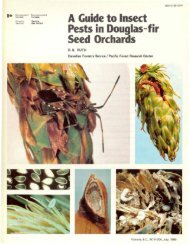Pacific Forestry Centre, Canadian Forest Service 506 West Burnside ...
Pacific Forestry Centre, Canadian Forest Service 506 West Burnside ...
Pacific Forestry Centre, Canadian Forest Service 506 West Burnside ...
You also want an ePaper? Increase the reach of your titles
YUMPU automatically turns print PDFs into web optimized ePapers that Google loves.
The Carbon Chemistry of Peat:<br />
Current Knowledge and Research Needs for Climate Change Issues<br />
Caroline M. Preston<br />
<strong>Pacific</strong> <strong><strong>Forest</strong>ry</strong> <strong>Centre</strong>, <strong>Canadian</strong> <strong>Forest</strong> <strong>Service</strong><br />
<strong>506</strong> <strong>West</strong> <strong>Burnside</strong> Road, Victoria, British Columbia, Canada V8Z IM5<br />
E-mail: cpreston@nrcan.gc.ca<br />
l<br />
.<br />
s-<br />
a,<br />
In.<br />
)0.<br />
I1d<br />
tao<br />
eal<br />
cal<br />
ion<br />
52.<br />
W.;<br />
md<br />
30il<br />
Introduction<br />
Peat accumulates in wet environments where<br />
the rate of accumulation of plant biomass exceeds<br />
that of decomposition. It may be many meters<br />
deep and thousands of years old at the base, and<br />
it thus affords a valuable record of past environmental<br />
conditions (Campbell et al. 2000)_ Below<br />
the first few centimeters, decomposition is mainly<br />
hindered by lack of oxygen. Peat is essentially<br />
compressed plant litter, often very little affected<br />
by decomposition. Understanding its chemical<br />
composition and decomposition pathways<br />
requires the techniques widely used in studies of<br />
soil organic matter (Preston 1996, 2001; Kogel<br />
Knabner 2000), coalification (Chague-Goff and<br />
Fyfe 1996; Dudley et al. 1990) and organic<br />
geochemistry (van der Heijden and Boon 1994;<br />
Hedges and Oades 1997; Hedges et al. 2000;<br />
Lichtfouse 2000). This basic understanding<br />
ultimately must underlie our efforts to predict the<br />
effects of climate change on peatlands and to<br />
enhance the development of mitigation or<br />
management strategies.<br />
Methods for Characterization of Peat<br />
General Methods<br />
Peatlands have long been used for extraction<br />
of fuel, planting media, and raw materials for<br />
environmental remediation and chemical products,<br />
and drained for agriculture and managed<br />
forestry. Therefore, much research has been<br />
driven by practical considerations (Mathur et al.<br />
1984; Preston et al. 1986; Sped ding 1988;<br />
Humphey and Pluth 1996), and assessment of<br />
peat quality has been of longstanding interest<br />
(Levesque and Dinel 1978, 1982; Brown et al. 1990;<br />
Malterer et al. 1992). Two key components are<br />
botanical composition and degree of decomposition,<br />
the latter comprising a wide array of physical<br />
and chemical properties. In terms of botanical<br />
composition, peats or peat layers may be derived<br />
primarily from Sphagnum moss, sedges and other<br />
higher plants, or woody inputs.<br />
The von Post and rubbed fiber techniques<br />
have been commonly used to assess physical properties<br />
related to the degree of decomposition of<br />
peat. These methods are based on the breakdown<br />
of plant fibers to smaller particles through<br />
decomposition_ The von Post index is particularly<br />
simple and suitable for field use, as it is based on<br />
how the substrate runs through the fingers when<br />
squeezed, whereas determination of rubbed fiber<br />
content requires simple laboratory equipment.<br />
The water-holding properties of peat have also<br />
been of great interest, especially as a single<br />
peatland may have several pools of water with<br />
different degrees of binding (Holmgren et al. 1990;<br />
Preston n.d.). These properties affect the drying<br />
characteristics of peat for commercial use, but also<br />
such characteristics as gas diffusion, which can<br />
influence drainage efficiency and methane release<br />
(Aravena et al. 1993; Buttler et al. 1994).<br />
Because wetlands are generally nutrientlimited<br />
systems, peats tend have high total carbon<br />
(C) and high C/N (C to nitrogen) ratios. As<br />
decomposition proceeds, the general tendency is<br />
for C to decrease and N to increase, which results<br />
in a decreasing C to N ratio, while bulk density,<br />
ash content, and cation-exchange capacity all<br />
increase_ As a substitute for accurate C analysis<br />
through combustion, the Walkley-Black method<br />
or approximations based on loss on ignition are,<br />
unfortunately, still being used; the resulting data<br />
cannnot be considered reliable, especially as the<br />
basis for large-scale assessment of C stocks or as<br />
input for modeling. The C and N isotope<br />
composition of plants and organic matter (l)13C<br />
and l)15N) are also sensitive to plant inputs,<br />
environmental conditions including agricultural<br />
-383<br />
In!<br />
NOR-X-383<br />
29
practices, and decomposition processes (DeLaune<br />
1986; Price et al. 1997; Ficken et al. 1998; Kalbitz et<br />
al. 2000; Kracht and Gleixner 2000; Rice 2000;<br />
Menot and Burns 2001; Preston, Bhatti et al. n.d.).<br />
Organic Components<br />
Beyond bulk physical and chemical<br />
properties, the C composition of peat can be<br />
characterized by a variety of organic chemical and<br />
spectroscopic techniques. Proximate analysis (PA)<br />
has long been used in studies of litter decomposition<br />
and organic matter. Samples are sequentially<br />
extracted to remove nonpolar extractable components<br />
and then polar extractable components, and<br />
are then hydrolyzed in sulfuric acid to yield an<br />
acid-insoluble residue (AIR). This approach was<br />
developed for wood products and forage analysis,<br />
and is based on a structural model of extractables<br />
(including phenolics and soluble carbohydrates),<br />
celluloses, and lignin. It has recently been<br />
adapted to quantify nine organic fractions of<br />
Sphagnum-derived peats (Wieder and Starr 1998).<br />
However, these operationally defined fractions<br />
are inadequate to define more complex plant substrates<br />
incorporating cutin, suberin, and tannin<br />
structures, especially if modified by decomposition<br />
(Preston et al. 1997).<br />
This limitation has led to overuse of the term<br />
"lignin" (from "Klason lignin", the AIR from PA of<br />
wood) for the AIR fraction. However, it reflects<br />
contributions from three biopolymer components:<br />
cutin (or suberin), condensed tannins, and lignin<br />
(Ha et al. 1997; Preston et al. 1997). The latter is<br />
properly defined as a polymer of phenylpropane<br />
units, with zero, one, or two methoxyl substituents<br />
(hydroxyphenyl, guaiacyl, and syringyl units,<br />
respectively), and may be present at lower concentration<br />
than the other components. Lower plants,<br />
including Sphagnum and all mosses, do not even<br />
contain lignin (Williams et al. 1998), although<br />
other phenolics are present (Wilson et al. 1989),<br />
especially sphagnum acid (Rasmussen et al. 1995;<br />
Williams et al. 1998).<br />
Recent geochemical research focuses much<br />
more on specific chemical degradations, pyrolysis,<br />
gas chromatography, and mass spectrometry to<br />
generate molecular-level analysis of biochemical<br />
components, such as individual lipids, amino<br />
acids, lignin fragments, condensed tannins, and<br />
monosaccharides. There has also been rapid development<br />
of compound-specific isotope analysis<br />
(Macko et al. 1991; Lichtfouse 2000). There is little<br />
information on individual amino acids in peats<br />
(Preston et al. 1981; Macko et al. 1991), but total<br />
amounts, molar distribution, and stereochemistry<br />
(levorotary versus dextrorotary) are all sensitive to<br />
imputs and decomposition. Lipids generally<br />
accumulate with decomposition, and there is some<br />
information on lipids in peat, although mainly<br />
those amenable to extraction (Karunen and<br />
Kiilviiiinen 1988; Lehtonen and Ketola 1993; Baas et<br />
al. 2000; Nott et al. 2000).<br />
Tannins (especially condensed tannins) are<br />
common in higher plants and, like lignin, absent<br />
from mosses (Preston et al. 1997; Preston 1999;<br />
Preston et al. 2000). While levels of chemically<br />
identifiable tannins usually decrease rapidly with<br />
decomposition, C structures derived from tannins<br />
may still be detected in peat and humus by<br />
nuclear magnetic resonance (NMR) (see next<br />
section). Occasional high levels of tannins (up to<br />
4%) have been found in black spruce humus<br />
(Lorenz et al. 2000; Preston 2001) and may be<br />
related to high water tables. Molecular-level<br />
analysis of tannin monomer components in soil or<br />
sediment is still under development (Hernes and<br />
Hedges 2000), but a specific colorimetric analysis<br />
for extractable and nonextractable tannins<br />
(Preston 1999; Lorenz et al. 2000) can provide<br />
valuable insight into peat plant sources and<br />
decomposition processes. Using the Folin-Dennis<br />
or Folin-Ciocalteu method to analyze total<br />
phenolics of the polar extract of PA does not<br />
distinguish condensed tannins from other classes<br />
of phenolics; in addition, the extraction procedures<br />
are not optimized for condensed tannins.<br />
Hydrolysis followed by analysis of individual<br />
monosaccharides is particularly useful for following<br />
the effects of decomposition, as the<br />
monosaccharide profile changes from plant to<br />
microbial (Morita et al. 1983; Moers et al. 1989;<br />
Moers et al. 1990; Macko et al. 1991). Analysis of<br />
lignin fragments has also proved extremely useful<br />
for understanding plant inputs and transformations<br />
due to decomposition. Although mosses do<br />
not contain lignin, they do yield some phenolics<br />
(Williams et al. 1998), and litter inputs from higher<br />
plants leave their characteristic lignin signatures.<br />
The search for rapid methods to capture the<br />
chemicat botanical, and microbiological properties<br />
of peat has stimulated application of Fourier<br />
transform infrared spectroscopy with principal<br />
30<br />
In! Rep. NOR-X-383
t<br />
e<br />
t<br />
9;<br />
y<br />
s<br />
y<br />
xt<br />
to<br />
us<br />
be<br />
el<br />
or<br />
d<br />
sis<br />
ns<br />
ide<br />
md<br />
is<br />
)tal<br />
not<br />
;ses<br />
)celual<br />
owthe<br />
t to<br />
989;<br />
is of<br />
;eful<br />
:masdo<br />
olics<br />
gher<br />
:res.<br />
the<br />
)perurier<br />
dpal<br />
component analysis (Holmgren and Norden 1988;<br />
Holmgren et al. 1990; Chapman et al. 2001).<br />
However, the predictive ability of this method is<br />
generally limited to samples very similar to those<br />
in the classification set. Electron paramagnetic<br />
resonance spectroscopy has less diagnostic value,<br />
as it mainly shows a general tendency for free<br />
radicals to increase with decomposition (Holmgren<br />
et al. 1990; Karlstrom et al. 1994).<br />
Carbon-13 NMR of Peat<br />
A general problem with geochemical analysis<br />
techniques is that the yields of identifiable<br />
compounds cannot account for all of the C<br />
structures, even in fresh plant materials, and may<br />
decrease severely with increasing decomposition<br />
(Hedges et al. 2000). Carbon-13 (13C) NMR<br />
spectroscopy is a powerful technique that yields<br />
an overall characterization or fingerprint of the<br />
organic composition of complex substrates such<br />
as fresh plant material, litter inputs, organic<br />
matter (Preston 1996, 2001; Kogel-Knabner 2000),<br />
and peats and mucks (Preston and Ripmeester<br />
1982; Hammond et al. 1985; Preston et al. 1987;<br />
Norden and Albano 1989; Preston et al. 1989;<br />
Holmgren et al. 1990; Norden et al. 1992; Bergman<br />
et al. 2000). It is carried out on dry, powdered<br />
solids and thus can be used to examine intact<br />
samples or physical or chemical fractions. It uses<br />
high-speed spinning (magic-angle spinning or<br />
MAS), usually combined with cross-polarization<br />
(CP) from hydrogen nuclei to enhance sensitivity,<br />
the combined experiment being known as<br />
CPMAS NMR. There are definite limitations to its<br />
quantitative reliability, that is, its ability to detect<br />
all types of C with equal sensitivity. However, 20<br />
years on, these phenomena are well understood,<br />
and quantitative or semiquantitative spectra can<br />
be obtained under suitable experimental conditions,<br />
especially for samples high i:t:l<br />
.<br />
total C (Hu et<br />
al. 2000; Preston 2001).<br />
Figure 1 shows spectra of size fractions of two<br />
peats differing in degree of decomposition (from<br />
Preston et al. 1989). Spectra of Sphagnum and<br />
poorly decomposed peat typically have a large<br />
signal at 73 ppm from polysaccharides (C-2, C-3,<br />
and C-5), the major biochemical component. This<br />
is accompanied by the peak for anomeric C (C-1 of<br />
polysaccharides) at 105 ppm. The peak at 30 ppm<br />
comes from alkyl C, especially in long chains<br />
(-CH2-), and the carboxyl signal (173 ppm)<br />
includes contributions from free acids, amides,<br />
and esters. There is little intensity in the aromatic<br />
and phenolic regions (112-140 and 140-160 ppm,<br />
respectively).<br />
Changes in C Composition with Decomposition<br />
The changes due to decomposition (here<br />
reflected in decreasing particle size) are clearly<br />
shown by NMR. The accumulation of organic<br />
GATINEAU<br />
>2000 m<br />
Figure 1.<br />
FARNHAM<br />
>2000 m<br />
200 100 o ppm<br />
Carbon-13 cross-polarization magic-angle<br />
spinning nuclear magnetic resonance<br />
spectra of particle-size fractions of poorly<br />
decomposed Gatineau Sphagnum peat<br />
and well-decomposed Farnham peat with<br />
composition of 50% wood, 40% sedge,<br />
and 10% mosses. Reprinted from Organic<br />
Geochemistry, Volume 14, CM. Preston,<br />
D.E. Axelson, M. Levesque, S.P. Mathur, H.<br />
Dinel, and R.L. Dudley. Carbon-13 NMR<br />
and chemical characterization of particlesize<br />
separates of peats differing in degree<br />
of decomposition, pages 393-403, copyright<br />
1989, with permission from Elsevier<br />
Science.<br />
-X-383<br />
In! Rep. NOR-X-383<br />
31
matter in upland or wetland ecosystems (development<br />
of Folisols or Histosols) is due to conditions<br />
that restrict decomposition. These may include<br />
low temperatures, low oxygen and nutrient<br />
supply, excessive moisture, lack of earthworm<br />
activity, and the chemical composition of litter<br />
inputs (known as "litter quality"). The latter is a<br />
complex concept comprising nutrient content,<br />
organic composition, and physical toughness.<br />
The consequences of organic composition are<br />
poorly understood, but hard-to-decompose litter<br />
tends to be associated with high content of<br />
tannins, suberin (from bark), cutin (from leaves<br />
and fruits), and lignin from wood. Even celluose<br />
may be in this category, if highly crystalline and<br />
well protected by association with other<br />
components (Huang et al. 1998; Preston et al.<br />
2000), whereas sphagnic acid may have a specific<br />
inhibitory effect (Verhoeven and Toth 1995).<br />
NMR studies have consistently shown that<br />
decomposition in peat is associated with a relative<br />
increase in alkyl C (lipids, 0-50 ppm) and a<br />
decrease in 0- and di-O-alkyl C (60-110 ppm)<br />
mainly associated with polysaccharides. There<br />
may be a small accumulation of carboxyl C<br />
(including ami des and esters), but there is often<br />
little or no change in aromatic C (Hammond et al.<br />
1985; Preston et al. 1987; Preston et al. 1989;<br />
Holmgren et al. 1990; Norden et al. 1992; Baldock<br />
and Preston 1995). Thus, increases in "lignin"<br />
content indicated by PA may have much less to do<br />
with accumulation of aromatics than with<br />
accumulation of alkyl C-based components.<br />
Accumulation of lignin with high aromaticity in<br />
forest floor and Lignic Folisols is generally<br />
associated with large inputs of coarse woody<br />
debris (de Montigny et al. 1993; Fox et al. 1994;<br />
Preston et al. 1998; Preston 1999; Preston,<br />
Trofymow et al. n.d.). It was found by 13C CPMAS<br />
NMR analysis of a woody peat from Brazil (Freitas<br />
et al. 1999) and a peatified log from Indonesia<br />
(Bates et al. 1991). Charcoal is also a source of<br />
high aromaticity in organic matter (Preston,<br />
Trofymow et al. n.d.; Schmidt and Noack 2000),<br />
and thus may also influence some peat sites<br />
(Campbell et al. 2000).<br />
NMR spectra of organic matter fractions high<br />
in charcoal or lignin from highly decayed wood<br />
are shown in Figure 2. For the charcoal-rich<br />
sample, the prominent peat at 128 ppm comes<br />
from highly condensed aromatic structures and<br />
that at 30 ppm from the accumulation of alkyl C.<br />
The spectrum for lignin-rich samples includes<br />
characteristic lignin peaks at 148 ppm for phenolic<br />
C, 112-140 ppm for aromatic C, and 56 ppm for<br />
methoxyl C. Both spectra also have the main peak<br />
for cellulose-hemicellulose at 73 ppm and for the<br />
aromeric C-1 at 105 ppm.<br />
Research Needs for Climate Change Issues<br />
For climate change issues, filling the knowledge<br />
gaps in peat chemistry and decomposition<br />
will increase interdisciplinary cooperation.<br />
Peatlands hold vast amounts of C and factors<br />
controlling decomposition, DOC and methane<br />
release, and long-term C storage cannot be<br />
understood without reference to organic C<br />
chemistry. As noted earlier, much previous<br />
research on the C chemistry of peat and its<br />
decomposition pathways has been driven by<br />
issues surrounding the commercial use of peat or<br />
to provide insight into coal formation. Many of<br />
the detailed molecular-level studies only account<br />
for a very small fraction of the total C, and much<br />
chemical and isotope work has been from<br />
temperate or tropical peats. There are few studies<br />
providing the specific chemistry and process<br />
High charcoal<br />
High lignin<br />
ppm 200<br />
Figure 2.<br />
ro<br />
N<br />
100<br />
co<br />
LO<br />
Carbon-13 cross-polarization magic-angle<br />
spinning nuclear magnetic resonance<br />
spectra of charcoal-rich and lignin-rich<br />
samples of the 2- to 8-mm water-floatable<br />
fraction from 10-30 em depth of British<br />
Columbia coastal forests (project<br />
described in Preston, Trofymow et al. n.d.).<br />
o<br />
32<br />
In! Rep. NOR-X-383
.<br />
s<br />
e<br />
e<br />
S<br />
ts<br />
y<br />
r<br />
of<br />
nt<br />
ch<br />
m<br />
es<br />
sS<br />
mgle<br />
lance<br />
l-rich<br />
table<br />
:ritish<br />
'oject<br />
n.d.).<br />
:-X-383<br />
;:}<br />
f<br />
i<br />
<br />
<br />
I<br />
<br />
I<br />
I<br />
I<br />
I<br />
I<br />
<br />
information to complement large-scale studies of<br />
C fluxes and stocks, and the associated modeling<br />
exercises. The NMR studies analyzed peats with<br />
various degrees of decomposition as assessed by<br />
other techniques, and there do not appear to be<br />
any NMR or molecular-level analyses of timecourse<br />
decomposition studies, not even to<br />
characterize the starting materials.<br />
Climate change issues have recently stimulated<br />
much research on C stocks and fluxes in<br />
peatlands, including C isotope studies. However,<br />
this has not been accompanied by corresponding<br />
advances in C chemistry. Recent studies of<br />
decomposition have focused on environmental<br />
controls of mass loss, with assessment of substrate<br />
quality largely restricted to C and N contents<br />
(Farrish and Grigal 1988; Braeke and Finer 1990;<br />
Johnson and Damman 1991; Szumigalski and<br />
Bayley 1996; Thormann and Bayley 1997; Latter et<br />
al. 1998; Hartmann 1999; Scheffer and Aerts 2000;<br />
Thormann et al. 2001). Two studies of peat soils<br />
(rather than fresh litter) showed the importance of<br />
distinguishing different pools of C and also the<br />
limitations of PA to explain C, N, and P<br />
mineralization (Updegraff et al. 1995; Bridgham et<br />
al. 1998); by contrast the simple von Post measure<br />
of decomposition was more successful.<br />
Liihdesmiiki and Piispanen (1988) examined<br />
sequences of fresh leaves, litter, and humus<br />
through PA and enzyme activity. Very narrowly<br />
focused studies of enzyme activities (Pind et al.<br />
1994, Freeman et al. 1996) culminated in the claim<br />
that limited activity of one enzyme - phenol<br />
oxidase - could be the controlling factor for C<br />
storage in peat (Freeman et al. 2001).<br />
Compared with the efforts expended for<br />
forests, grasslands, and agriculture, there has been<br />
little detailed process work on C flows and<br />
transformations in wetlands. Some recent studies<br />
used carbon-14 labeling to track the fate of C from<br />
litter (Domish et al. 2000) and recently assimilated<br />
C (Richart et al. 2000). The metabolic pathways of<br />
13C-Iabeled glucose were followed with varying<br />
pH, temperature, and redox conditions (Bergman<br />
et al. 1999; Bergman et al. 2000). Van den Pol-van<br />
Dasselaar and Oenema (1999) determined<br />
methane and carbon dioxide (C02) production<br />
from size and density fractions of peat.<br />
Factors controlling production of C02,<br />
methane, and DOC have been examined by Moore<br />
and Dalva (1997, 2001) and by Scanlon and Moore<br />
In! Rep. NOR-X-383<br />
(2000); the latter found that CO2 production was<br />
best correlated with the von Post index of<br />
decomposition. Other recent research indicates<br />
that the radiocarbon age of peatland DOC may<br />
differ from that of the bulk peat, and that the<br />
complexities of DOC formation and movement<br />
require further investigation (Aravena et al. 1993;<br />
Bellisario et al. 1999; Chasar et al. 2000; Kracht and<br />
Gleixner 2000; Palmer et al. 2001). Compared with<br />
our understanding of DOC in forest soils<br />
(Guggenberger and Zech 1993, 1994; Kaiser et al.<br />
2000), there has been very little chemical investigation<br />
of DOC from peatlands (Kracht and<br />
Gleixner 2000).<br />
While environmental factors exert the<br />
primary control, substrate quality secondarily<br />
influences decomposition (Preston et al. 2000) and<br />
associated releases of dissolved and gaseous<br />
products. Its influence may be more important<br />
where decomposition is hindered by unfavorable<br />
environmental conditions. Addressing the<br />
significant current questions on C stocks and<br />
fluxes in peatlands, especially in Canada's boreal<br />
regions, requires an interdisciplinary approach to<br />
examine the relevant C chemistry with the<br />
appropriate analytical tools.<br />
References<br />
Aravena, R.; Warner, B.G.; Charman, D.J.; Belyea, L.R.; Mathur,<br />
S.P.; Dine!, H. 1993. Carbon isotopic composition of deep<br />
carbon gases in an ombrogenous peatland, northwestern<br />
Ontario, Canada. Radiocarbon 35:271-276.<br />
Baas, M.; Pancost, R.; van Geel, B.; Damste, J.s.S. 2000. A<br />
comparative study of lipids in Sphagnum species. Org.<br />
Geochem. 31:535--541.<br />
Baldock, J. A.; Preston, C.M. 1995. Chemistry of carbon<br />
decomposition processes in forests as revealed by solidstate<br />
13C nuclear magnetic resonance. Pages 89-117 in<br />
Carbon forms and functions in forest soils. W.W. McFee<br />
and J.M. Kelly, eds. Soil Science Society of America,<br />
Madison, WI.<br />
Bates, A.L.; Hatcher, P.G.; Lerch, H.E., Ill; Cecil, c.B.; Neuzil,<br />
S.G.; Supardi, X.G. 1991. Studies of a peatified<br />
angiosperm log cross section from Indonesia by nuclear<br />
magnetic resonance spectroscopy and analytical<br />
pyrolysis. Org. Geochem. 17:37-45.<br />
Bellisario, L.M.; Bubier, J.L.; Moore, T.R.; Chanton, J.P. 1999.<br />
Controls on Clf. emissions from a northern peatland.<br />
Glob. Biogeochem. Cycles 13:81-89.<br />
Bergman, 1.; Lundberg, P.; Nilsson, M. 1999. Microbial carbon<br />
mineralization in an acid surface peat: effects of<br />
33
environmental factors in laboratory incubations. Soil BioI.<br />
Biochem. 31:1867-1877.<br />
Bergman, I.; Lundberg, P.; Preston, CM.; Nilsson, M. 2000.<br />
Degradation of "C-U-glucose in Sphagnum majus litter:<br />
responses to redox, pH and temperature. Soil Sci. Soc.<br />
Am. J. 64:1368-1381.<br />
Braekke, F.H.; Finer, L. 1990. Decomposition of cellulose in<br />
litter layer and surface peat of low-shrub pine bogs.<br />
Scand. J. For. Res. 5:297-310.<br />
Bridgham, S.D.; Updegraff, K; Pastor, J. 1998. Carbon, nitrogen<br />
and phosphorus mineralization in northern wetlands.<br />
Ecology 79:1545-1561.<br />
Brown, D.A; Mathur, S.P.; Brown, A; Kushner, D.J. 1990.<br />
Relationships between some properties of organic soils<br />
from the southern <strong>Canadian</strong> shield. Can. J. Soil Sci.<br />
90:363-377.<br />
Buttler, A; Dine!, H.; Levesque, P.E.M. 1994. Effects of physical,<br />
chemical and botanical characteristics of peat on carbon<br />
gas fluxes. Soil Sci. 158:365-374.<br />
Campbell, I.D.; Campbell, C; Yu, Z.; Vitt, D.H.; Apps, M.J.<br />
2000. Millennial-scale rhythms in peatlands in the<br />
western interior of Canada and in the global carbon cycle.<br />
Quat. Res. 54:155-158.<br />
Chague-Goff, C; Fyfe, W.5. 1996. Geochemical and<br />
petrographical characteristics of a domed bog, Nova<br />
Scotia: a modem analogue for temperate coal deposits.<br />
Org. Geochem. 24:141-158.<br />
Chapman, S.J.; Campbell, CD.; Fraser, AR; Puri, G. 2001. FTIR<br />
spectroscopy in peat in and bordering Scots pine<br />
woodland: relationship with chemical and biological<br />
properties. Soil BioI. Biochem. 33:1193-1200.<br />
Chasar, L.5.; Chanton, J.P.; Glaser, P.H.; Siegel, D.L; Rivers, J.5.<br />
2000. Radiocarbon and stable isotope evidence for<br />
transport and transformation of dissolved organic<br />
carbon, dissolved inorganic carbon and CH4 in a<br />
northern Minnesota peatland. Glob. Biogeochem. Cycles<br />
14:1095-1108.<br />
DeLaune, R.D. 1986. The use of S "C signature of C-3 and C-4<br />
plants in determining past depositional environments in<br />
rapidly accreting marshes of the Mississippi River deltaic<br />
plain, Louisiana, U.S.A Chern. Geol. 59:315-320.<br />
De Montigny, L.E.; Preston, CM.; Hatcher, P.G.; Kogel<br />
Knabner, I. 1993. Comparison of humus horizons from<br />
two ecosystem phases on Northern Vancouver Island<br />
using "C CPMAS NMR spectroscopy and CuO oxidation.<br />
Can. J. Soil Sci. 73:9-25.<br />
Domish, T.; Finer, L.; Laiho, R; Karisto, M.; Laine, J. 2000.<br />
Decomposition of Scots pine litter and the fate of released<br />
carbon in pristine and drained pine mires. Soil BioI.<br />
Biochem. 32:1571-1580.<br />
Dudley, RL.; Fyfe, CA; Preston, CM. 1990. A 13C-CPMAS<br />
NMR spectroscopic study of the transformation of plant<br />
material to peat and coal. Can. J. Spectrosc. 35:31-38.<br />
Farrish, KW.; Grigal, D.F. 1988. Decomposition in an<br />
ombrotrophic bog and a minerotrophic fen in Minnesota.<br />
Soil Sci. 145:353-358.<br />
Ficken, KJ.; Barber, KE.; Eglinton, G. 1998. Lipid biomarker,<br />
S'3C and plant macrofossil stratigraphy of a Scottish<br />
montane peat bog over the last two millennia. Org.<br />
Geochem. 28:217-237.<br />
Fox, CA.; Preston, CM.; Fyfe, CA 1994. Micromorphological<br />
and "C NMR characterization of a Humic, Lignic and<br />
Histic Folisol from British Columbia. Can. J. Soil Sci.<br />
74:1-15.<br />
Freeman, C; Liska, G.; Ostle, N.J.; Lock, M.A; Reynolds, B.;<br />
Hudson, J. 1996. Microbial activity and enzymatic<br />
decomposition processes following peatland water table<br />
drawdown. Plant Soil 180:121-127.<br />
Freeman, C; Ostle, N.; Kang, H. 2001. An enzymic 'latch' on a<br />
global carbon store. Nature 409:149.<br />
Freitas, J.CC; Bonagamba, T.J.; Emmerich, F.G. 1999. "C highresolution<br />
solid-state NMR study of peat carbonization.<br />
Energy Fuels 13:53-59.<br />
Guggenberger, G.; Zech, W. 1993. Dissolved organic carbon<br />
control in acid forest soils of the Fichtelgebirge (Germany)<br />
as revealed by distribution patterns and structural<br />
composition analyses. Geoderma 59:109-129.<br />
Guggenberger, G.; Zech, W. 1994. Dissolved organic carbon in<br />
forest floor leachates: simple degradation products or<br />
humic substances? Sci. Total Environ. 152:37-47.<br />
Ha, M.-A.; Jardine, w.G.; Jarvis, M.C 1997. Solid-state "C NMR<br />
of cell walls in wheat bran. J. Agric. Food Chern.<br />
45:117-119.<br />
Hammond, I.E.; Cory, D.G.; Ritchey, W.M.; Morita, H. 1985.<br />
High resolution solid state "C n.m.r. of <strong>Canadian</strong> peats.<br />
Fuel 64:1687-1695.<br />
Hartman, M. 1999. Species dependent root decomposition in<br />
rewetted fen soils. Plant Soil 213:93-98.<br />
Hedges, J.I.; Eglinton, G.; Hatcher, P.G.; Kirchman, D.L.;<br />
Arnosti, C; Derenne, 5.; Evershed, RP.; Kogel-Knabner, I.;<br />
de Leeuw, J.W.; Littke, R; Michaelis, w.; Rullkotter, J.<br />
2000. The molecularly uncharacterized component of<br />
nonliving organic matter in natural environments. Org.<br />
Geochem. 31:945-958.<br />
Hedges, J.I.; Oades, J.M. 1997. Comparative organic<br />
geochemistries of soils and marine sediments. Org.<br />
Geochem. 27:319-361.<br />
Hernes, P.J.; Hedges, J.I. 2000. Determination of condensed<br />
tannin monomers in environmental samples by capillary<br />
gas chromatography of acid depolymerization extracts.<br />
Anal. Chern. 72:5115-5124.<br />
Holmgren, A; Norden, B. 1988. Characterization of peat<br />
samples by diffuse reflectance FT-IR spectroscopy. Appl.<br />
Spectrosc. 42:255-262.<br />
Holmgren, A; Wiklander, G.; Norden, B. 1990. Spectroscopic<br />
investigations of peat-water interactions: an ESR, FT-IR<br />
and NMR study. Soil Sci. 149:279-291.<br />
Hu, w.-G.; Mao, J.; Xing, B.; Schmidt-Rohr, K 2000.<br />
Poly(methylene) crystallites in humic substances detected<br />
by nuclear magnetic resonance. Environ. Sci. Technol.<br />
34:530-534.<br />
Huang, Y.; Stankiewicz, B.A; Eglinton, G.; Snape, CE.; Evans,<br />
B.; Latter, P.M.; Ineson, P. 1998. Monitoring biomacromolecular<br />
degradation of Calluna vulgaris in a 23 year<br />
field experiment using solid state "C-NMR and<br />
pyrolysis-GC/MS. Soil BioI. Biochem. 30:1517-1528.<br />
34<br />
In! Rep. NOR-X-383
-<br />
.<br />
)<br />
l<br />
n<br />
r<br />
R<br />
.<br />
5.<br />
ts.<br />
in<br />
.L.;<br />
, 1.;<br />
, J.<br />
of<br />
)rg.<br />
lniC<br />
)rg.<br />
lsed<br />
llary<br />
acts.<br />
peat<br />
ppl.<br />
copic<br />
T-IR<br />
2000.<br />
:ected<br />
MOl.<br />
vansJ<br />
1acro<br />
I year<br />
3.<br />
and<br />
Humphrey, W.D.; Pluth, D.J. 1996. Net nitrogen mineralization<br />
in natural and drained fen peatlands in Alberta, Canada.<br />
Soil Sci. Soc. Am. J. 60:932-940.<br />
Johnson, L.C; Damman, A.W.H. 1991. Species-controlled<br />
Sphagnum decay on a south Swedish raised bog. Oikos<br />
61:234--242.<br />
Kaiser, K; Haumaier, L.; Zech, W. 2000. The sorption of organic<br />
matter in soils as affected by the nature of soil carbon. Soil<br />
Sci. 165:305--313.<br />
Kalbitz, K; Geyer, S.; Gehre, M. 2000. Land use impacts on the<br />
isotopic signature (I3C, 14C, 15N) of water-soluble fulvic<br />
acids in a German fen area. Soil Sci. 165:728-736.<br />
Karlstrom, H.; Norden, B.; Wiklander, G. 1994. Spectroscopic<br />
peat classification and calibration using electron spin<br />
resonance and multivariate data analysis. Soil Sci.<br />
157:300--311.<br />
Karunen, P.; Kalviainen, E. 1988. Lipids and hydroxycinnamic<br />
acids in cell walls of Eriophorum vagina tum. Phytochemistry<br />
27:2045--2048.<br />
Kogel-Knabner, 1. 2000. Analytical approaches for characterizing<br />
soil organic matter. Org. Geochem. 31:609-625.<br />
Kracht, 0.; Gleixner, G. 2000. Isotope analysis of pyrolysis<br />
products from Sphagnum peat and dissolved organic<br />
matter from bog water. Org. Geochem. 31:645-654.<br />
Lahdesmiiki, P.; Piispanen, R 1988. Degradation products and<br />
the hydrolytic enzyme activities in the soil humification<br />
process. Soil BioI. Biochem. 20:287-292.<br />
Latter, P.M.; Howson, G.; Howard, D.M.; Scott, W.A. 1998.<br />
Long-term study of litter decomposition on a Pennine<br />
peat bog: which regression? Oecologia 113:94--103.<br />
Lehtonen, K; Ketola, M. 1993. Solvent-extractable lipids of<br />
Sphagnum, Carex, BryaZes and Carex-BryaZes peats: content<br />
and compositional features vs peat humification. Org.<br />
Geochem. 20:363-380.<br />
Levesque, M.; Dinel, H. 1978. Applicability of thermal methods<br />
for characterization of peats and plants. Geoderma<br />
20:201-213.<br />
Levesque, M.P.; Dinel, H. 1982. Some morphological and<br />
chemical aspects of peats applied to the characterization<br />
of Histosols. Soil Sci. 133:324--332.<br />
Lichtfouse, E. 2000. Compound-specific isotope analysis.<br />
Application to archaeology, biomedical sciences,<br />
biosynthesis, environment, extraterrestrial chemistry,<br />
food science, forensic science, humic substances,<br />
microbiology, organic geochemistry, soil science and<br />
sport. Rapid Commun. Mass Spectrom. 14:1337-1344.<br />
Lorenz, K; Preston, CM.; Raspe, S.; Morrison, 1.K; Feger, K<br />
H. 2000. Litter decomposition and humus characteristics<br />
in <strong>Canadian</strong> and German spruce ecosystems: information<br />
from tannin analysis and I3C CPMAS NMR Soil BioI.<br />
Biochem. 32:779-792.<br />
Macko, S.A.; Engel, M.H.; Hartley, G.; Hatcher, P.; Helleur, R;<br />
Jackman, P.; Silfer, J.A. 1991. Isotopic compositions of<br />
individual carbohydrates as indicators of early diagenesis<br />
of organic matter in peat. Chern. Geol. 93:147-161.<br />
MaIterer, T.J.; Verry, E.S.; Erjavec, J. 1992. Fiber content and<br />
degree of decomposition of peats: review of national<br />
methods. Soil Sci. Soc. Am. J. 56:1200-1211.<br />
Mathur, S.P.; Sanderson, RB.; Belanger, A.; Valk, M.; Knibbe,<br />
E.N.; Preston, CM. 1984. The effect of copper applications<br />
on the movement of copper and other elements in organic<br />
soils. Water Air Soil Pollut. 22:277-288.<br />
Menot, G.; Bums, S.J. 2001. Carbon isotopes in ombrogenic<br />
peat bog plants as climatic indicators: calibration from an<br />
altitudinal transect in Switzerland. Org. Geochem.<br />
32:233-245.<br />
Moers, M.E.C; Baas, M.; Boon, J.J.; de Leeuw, J.w. 1990.<br />
Molecular characterization of total organic matter and<br />
carbohydrates in peat samples from a cypress swamp by<br />
pyrolysis-mass spectrometry and wet-chemical analysis.<br />
Biogeochemistry 11:251-277.<br />
Moers, M.E.C; Boon, J.J.; de Leeuw, J.W.; Baas, M.; Schenck,<br />
P.A. 1989. Carbohydrate speciation and Py-MS mapping<br />
of peat samples from a subtropical open marsh environment.<br />
Geochim. Cosmochim. Acta 53:2011-2021.<br />
Moore, T.R; Dalva, M. 1997. Methane and carbon dioxide<br />
exchange potentials of peat soils in aerobic and anaerobic<br />
laboratory incubations. Soil BioI. Biochem. 29:1157-1164.<br />
Moore, T.R; Dalva, M. 2001. Some controls on the release of<br />
dissolved organic carbon by plant tissues and soils. Soil<br />
Sci. 166:38-47.<br />
Morita, H. 1983. Monosaccharides as geochemical markers in<br />
peat. Can. J. Soil Sci. 63:161-166.<br />
Norden, B.; Albano, C 1989. Principal components analysis of<br />
complex n.m.r. spectra from heterogeneous material. Fuel<br />
68:771-775.<br />
Norden, B.; Bohlin, E.; Nilsson, M.; Albano, A.; Rockner, C<br />
1992. Characterization of particle size fractions of peat.<br />
An integrated biological, chemical, and spectroscopic<br />
approach. Soil Sci. 153:382-396.<br />
Nott, CJ.; Xie, S.; Avsejs, L.A.; Maddy, D.; Chambers, F.M.;<br />
Evershed, RP. 2000. n-Alkane distributions in ombrotrophic<br />
mires as indicators of vegetation change related to<br />
climatic variation. Org. Geochem. 31:231-235.<br />
Palmer, S.M.; Hope, D.; Billett, M.F.; Dawson, }.J.C; Bryant,<br />
C.L. 2001. Sources of organic and inorganic carbon in a<br />
headwater stream: evidence from carbon isotope studies.<br />
Biogeochemistry 52:321-338.<br />
Pind, A.; Freeman, C; Lock, M.A. 1994. Enzymic degradation<br />
of phenolic material in peatlands - measurement of<br />
phenol oxidase activity. Plant Soil 159:227-231.<br />
Preston, CM. 1996. Applications of NMR to soil organic matter<br />
analysis: history and prospects. Soil Sci. 161:144--166.<br />
Preston, C.M. 1999. Condensed tannins of salal (Gaultheria<br />
shallon Pursh): a contributing factor to seedling "growthcheck"<br />
on northern Vancouver Island? Pages 825-841 in<br />
Plant polyphenols 2:<br />
chemistry, biology, pharmacology,<br />
ecology. G.G. Gross, RW. Hemingway, and T. Yoshida,<br />
eds. Kluwer Academic/Plenum Publishers, New York,<br />
NY.<br />
Preston, CM. 2001. Carbon-13 solid-state NMR of soil organic<br />
matter - using the technique effectively. Can. J. Soil Sci.<br />
81:255-270.<br />
Preston, CM. n.d .. Section 3.1.2.2.b. Nuclear magnetic<br />
resonance (measurement of soil water content by nuclear<br />
magnetic resonance). In Methods of soil analysis: Part 1-<br />
,<br />
35
Physical methods. J.H. Dane and G.c. Topp, eds. Soil<br />
Science Society of America, Madision, WI. Forthcoming.<br />
Preston, C.M.; Axelson, D.E.; Levesque, M.; Mathur, S.P.; Dinel,<br />
H.; Dudley, RL. 1989. Carbon-13 NMR and chemical<br />
characterization of particle-size separates of peats<br />
differing in degree of decomposition.<br />
14:393--403.<br />
Org. Geochem.<br />
Preston, C.M.; Bhatti, J.S.; Siltanen, RM. n.d. What controls C<br />
sequestration? Characterization of soil C and N pools in<br />
forested upland and non-forested wetland sites along the<br />
boreal forest transect case study in central Canada. In<br />
Proceedings of the role of boreal forests and forestry in<br />
the global carbon budget. 8-12 May 2000. Edmonton, AB.<br />
Forthcoming.<br />
Preston, C.M.; Mathur, S.P.; Rauthan, B.S. 1981. The distribution<br />
of copper, amino compounds and humus fractions<br />
in organic soils of differing copper content. Soil Sci.<br />
131:344-352.<br />
Preston, C.M.; Ripmeester, J.A. 1982. Application of solution<br />
and solid-state 13C NMR to four organic soils, their humic<br />
acids, fulvic acids, humins and hydrolysis residues. Can.<br />
J. Spectrosc. 27:99-105.<br />
Preston, C.M.; Ripmeester, J.A.; Mathur, S.P.; Levesque, M.<br />
1986. Application of solution and solid-state multinuclear<br />
NMR to a peat-based composting system for fish and crab<br />
scrap. Can. J. Spectrosc. 31:63-69.<br />
Preston, C.M.; Shipitalo, S.-E.; Dudley; RL.; Fyfe, c.A.; Mathur,<br />
S.P.; Levesque, M. 1987. Comparison of 13C CPMAS NMR<br />
and chemical techniques for measuring the degree of<br />
decomposition in virgin and cultivated peat profiles. Can.<br />
J. Soil Sci. 67:187-198.<br />
Preston, C.M.; Trofymow, J.A.; <strong>Canadian</strong> Intersite Decomposition<br />
Experiment Working Group. 2000. Variability in<br />
litter quality and its relationship to litter decay in<br />
<strong>Canadian</strong> forests. Can. J. Bot. 78:1269-1287.<br />
Preston, C.M.; Trofymow, J.A.; Niu, J.; Fyfe, c.A. 1998. CPMAS<br />
"C NMR spectroscopy and chemical analysis of coarse<br />
woody debris in coastal forests of Vancouver Island. For.<br />
Ecol. Manage. 111:51-68.<br />
Preston, C.M.; Trofymow, J.A.; Niu, J.; Fyfe, C.A. n.d. Harvesting<br />
and climate effects on organic matter characteristics in<br />
British Columbia coastal forests J. Environ. Qual.<br />
Forthcoming.<br />
Preston, C.M.; Trofymow, J.A.; Sayer, B.G.; Niu, J. 1997. "C<br />
nuclear magnetic resonance spectroscopy with crosspolarization<br />
and magic-angle spinning investigation of the<br />
proximate analysis fractions used to assess litter quality in<br />
decomposition studies. Can. J. Bot. 75:1601-1613.<br />
Price, G.D.; McKenzie, J.E.; Pilcher, J.R; Hoper, S.T. 1997.<br />
Carbon-isotope variation in Sphagnum from hummockhollow<br />
complexes: implications for Holocene climate<br />
reconstruction. Holocene 7:229-233.<br />
Rasmussen, S.; Wolfe, c.; Rudolph, H. 1995. Compartmentalization<br />
of phenolic constituents in Sphagnum.<br />
Phytochemistry 38:35-39.<br />
Rice, S.K 2000. Variation in carbon isotope discrimination<br />
within and among Sphagnum species in a temperate<br />
wetland. Oecologia 123:1-8.<br />
Richart, M.; Saarnio, S.; }uutinen, S.; Sivola, J.; Augustin, J.;<br />
Merbach, W. 2000. Distribution of assimilated carbon in<br />
the system Phragmites australis-waterlogged peat after<br />
carbon-14 pulse labelling. BioI. Fertii. Soils 32:1-7.<br />
Scanlon, D.; Moore, T. 2000. Carbon dioxide production from<br />
peatland soil profiles: the influence of temperature, oxic/<br />
anoxic conditions and substrate. Soil Sci. 165:153--160.<br />
Scheffer, RA.; Aerts, R 2000. Root decomposition and soil<br />
nutrient and carbon cycling in two temperate fen<br />
ecosystems. Oikos 91:541-549.<br />
Schmidt, M.W.!.; Noack, A.G. 2000. Black carbon in soils and<br />
sediments:<br />
analysis, distribution, implications, and<br />
current challenges. Glob. Biogeochem. Cycles 14:777-793.<br />
Spedding, P.}. 1988. Peat. Fuel 67:883-900.<br />
Szumigalski, A.R; Bayley, S.E. 1996. Decomposition along a<br />
bog to rich fen gradient in central Alberta, Canada. Can. J.<br />
Bot. 74:573--581.<br />
Thormann, M.N.; Bayley, S.E. 1997. Decomposition along a<br />
moderate-rich fen-marsh peatland gradient in boreal<br />
Alberta, Canada. Wetlands 17:123--137.<br />
Thormann, M.N.; Bayley, S.E.; Currah, RS. 2001. Comparison<br />
of decomposition of below ground and aboveground<br />
litters in peatlands of boreal Alberta, Canada. Can. }. Bot.<br />
79:9-22.<br />
Updegraff, K; Pastor, J.; Bridgham, S.D.; Johnston, c.A. 1995.<br />
Environmental and substrate controls over carbon and<br />
nitrogen mineralization in northern wetlands. Ecol. Appl.<br />
5:151-163.<br />
Van den Pol-van Dasselaar, A.; Oenema, O. 1999. Methane<br />
production and carbon mineralization of size and<br />
density fractions of peat soils. Soil BioI. Biochem.<br />
31:877-886.<br />
Van der Heijen, E.; Boon, J.J. 1994. A combined pyrolysis mass<br />
spectrometric and light microscopic study of peatified<br />
Calluna wood isolated from raised bog peat deposits. Org.<br />
Geochem. 22:903--919.<br />
Verhoeven, J.T.A.; Toth, E. 1995. Decomposition of Carex and<br />
Sphagnum litter in fens: effect of litter quality and<br />
inhibition by living tissue homogenates. Soil BioI.<br />
Biochem. 27:271-275.<br />
Wieder, RK; Starr, S.T. 1998. Quantitative determination of<br />
organic fractions in highly organic, Sphagum peat soils.<br />
Commun. Soil Sci. Plant Anal. 29:847-857.<br />
Williams, C.}.; Yavitt, J.B.; Wieder, RK; Cleavitt, N.L. 1998.<br />
Cupric oxide oxidation products of northern peat and<br />
peat-forming plants. Can. J. Bot. 76:51-62.<br />
Wilson, M.A.; Sawyer, J.; Hatcher, P.G.; Lerch, H.E., III. 1989.<br />
1,3,5-Hydroxybenzene structures in mosses.<br />
Phytochemistry 28:1395-1400.<br />
36<br />
Inf. Rep. NOR-X-383


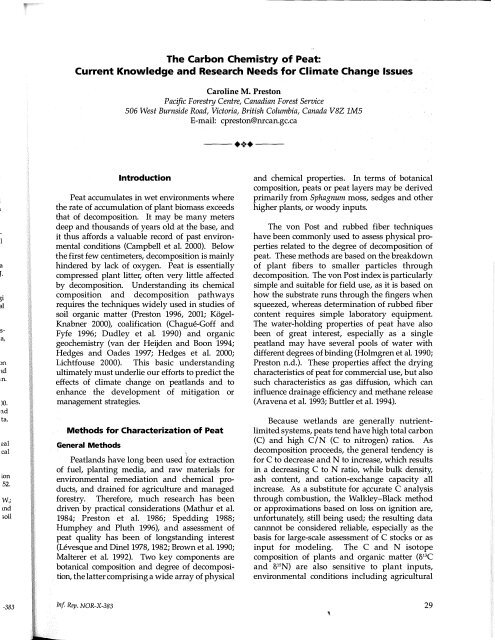
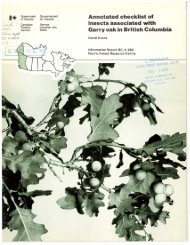
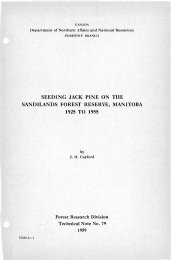
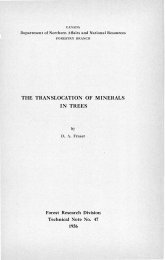


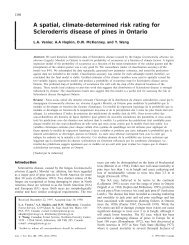

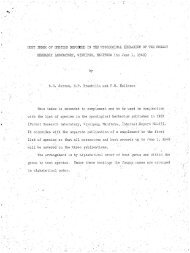
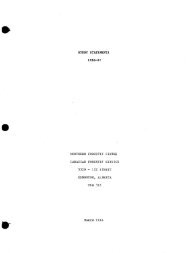
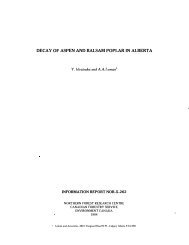
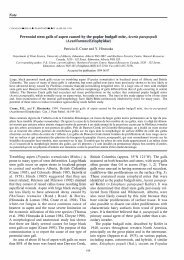
![Po],rell](https://img.yumpu.com/11946277/1/190x231/porell.jpg?quality=85)
